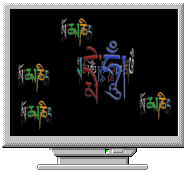
Stof om de Helix-nevel (zie ook hier).
Voornemens 2010:
1. Luister naar de innerlijke stem[1].
2. Wandel elke dag ongeveer een uur[2].
3. Sta op tijd op en ga op tijd naar bed.
4. Laat de pc uit in het weekend, op woensdag (of donderdag) en 's avonds.
En verder:
5. Oordeel minder en onderzoek meer[3].
6. Handel in het besef dat de ander deels is wat jij van haar/hem maakt[4].
7. Herken pessimisme (en optimisme) en laat het los met een glimlach[5].
8. Wees vrijgeviger[6].
[1] Vergelijk de stem van de 'grote geest' waarover Shunryu Susuki spreekt, die hoorbaar wordt als de 'kleine geest' tot rust komt. Of de 'daimon' van Socrates. De innerlijke stem waarschuwt 'feilloos' als je op het punt staat de speelruimte voor vrije, constructieve en bij de ander welkome expressie te overschrijden - je weet altijd of je je eigen grenzen, die van een ander of van een ding of de natuur dreigt te schenden of al schendt. Je ontplooit je geweldloos, ongeforceerd en vol aandacht in het gebied tussen je eigen grenzen (mentaal en fysiek) en die van andere mensen, dieren, planten, dingen of de natuur. Je verkeert in de evenwichtige, kwieke en harmonieuze gemoedstoestand van sattva tussen inertie (rajas) en agitatie (tamas).
Doe het juiste en meest eenvoudige: dat wat de innerlijke stem aangeeft. Dan richt je geen schade aan (wat trouwens energie vreet) bij jezelf, de ander, een ding of de natuur. Je voorkomt teleurstellingen en vervelende reacties en vervolgens boos worden daarover. Je bent niet obsessief of dwangmatig. Je pleegt geen roofbouw op je lichaam en werkt niemand op de zenuwen. Je hebt nooit haast. Je begint tijdig en stopt tijdig. Je bent een meester in het doseren, pauzeren en timen: de speelruimte-in-de-tijd waarnemen en te baat nemen. Denk aan wat Michel de Montaigne zegt over wie zijn werk niet weet te onderbreken om nieuwe energie en inspiratie op te doen: zo iemand is kleingeestig. Humor en kunnen lachen in plaats van irritatie en verbetenheid krijgen een kans. Je staat open voor de ander en hebt de gelegenheid en de inspiratie iets voor de ander te betekenen.
Je ademt altijd rustig en goed.
[2] Breid dit geleidelijk uit met dagelijks rustig korte strek- en ontspanningsoefeningen en circa een half uur aandachtig zitten op het meditatiebankje. Altijd kalm en weldadig blijven ademen!
[3] Onthoud je van ijdel geredetwist, gekissebis, geruzie en meninkjes spuien, ook op internet; omarm je woede (niet onderdrukken of afreageren) en bespreek tijdig en respectvol wat je dwars zit. Zit een ander niet op de huid met corrigerende, belerende, betweterige opmerkingen. Blijf niet steken in pissige en zure commentaren, ontsteek niet telkens in woede, hou op met zeiken, zeuren en klagen.
[4] Besef altijd dat de expressie, het doen en laten, van de ander essentieel wordt meebepaald door de impressie - onder meer welke jij hebt van de ander - die jij aan hem of haar geeft: de ander is zowel zichzelf als wat jij van hem of haar maakt. Jij kunt helpen het mooie van de ander tot uitdrukking te laten komen en de lelijke tendensen tot rust te brengen. En vice versa. Dit is het wonder van de intersubjectiviteit van het zijn (Theo van Velthoven) en - uitgebreid tot alle zijnden - van interzijn (Thich Nhat Hanh). In zoverre je dit lukt, zal wat je in de ander naar voren helpt komen ook weer jouw betere eigenschappen activeren enzovoorts; zo ontstaat een goede sfeer (Peter Sloterdijk) en een communicatieve positieve in plaats van een negatieve spiraal - 'verlossende' communicatie in tegenwoordigheid van geest.
[5] Denk aan het verhaaltje over de Chinese boer wiens zoon afwisselend slechte en goede dingen overkomen (verteld door Bertus Aafjes dacht ik): hij blijft in balans (yin-yang), terwijl omstanders hem willen aanpraten dat hij afwisselend in zak en as en in de zevende hemel dient te verkeren. En aan het gezegde van Johan Cruijff: 'elk nadeel hep ze voordeel (en elk voordeel hep ze nadeel)'. Onderken dat je meestal gewoon niet weet hoe het zal aflopen: leer leven met onzekerheid en maak die niet ongedaan door het schijnhouvast van doemscenario's (die inert maken) of valse hoop (die agitatie veroorzaakt). Word geen 'ramptoerist aan de oever van de tijd' die stiekem hoopt dat het slecht gaat aflopen en dus eigenlijk bespookt wordt door leedvermaak. Essentieel is ook dat je enthousiasme en levenslust en -moed van de ander niet de kop in drukt met somber, ontmoedigend gepraat.
[6] Waarschuwend beeld van hoe het mis kan gaan: de tekening 'Rekenende grijsaard' van Paul Klee. Probeer vrijgeviger te zijn in drie opzichten:
- financieel: vergeet mooie momenten niet te vieren, waar soms geld uitgeven bij komt kijken en leef sowieso wat 'feestelijker' door jezelf en anderen plezier te gunnen ook op materieel gebied (wel zoveel mogelijk spullen die EKO en Fair Trade zijn, maar wees daar niet perfectionistisch in);
- met tijd en energie: neem de tijd voor de ander, heb geduld, luister en wees desgevraagd en waar mogelijk (wat je eigen situatie en welzijn betreft) hulpvaardig;
- in het honoreren van de vrijgevigheid van de ander: ook ontvangen is een vorm van schenken; ga vaker in op uitnodigingen, sla niet te snel af wat je wordt aangeboden of voorgesteld. Peter Sloterdijk stelt in Sferen dat wie zich niet genoeg kan overgeven aan het ondervinden van wat in zekere zin bezit van je neemt en je zelfcontrole overvleugelt, geen sterke persoonlijkheid ('zelf') heeft, maar juist een zwakke en bangelijke.










